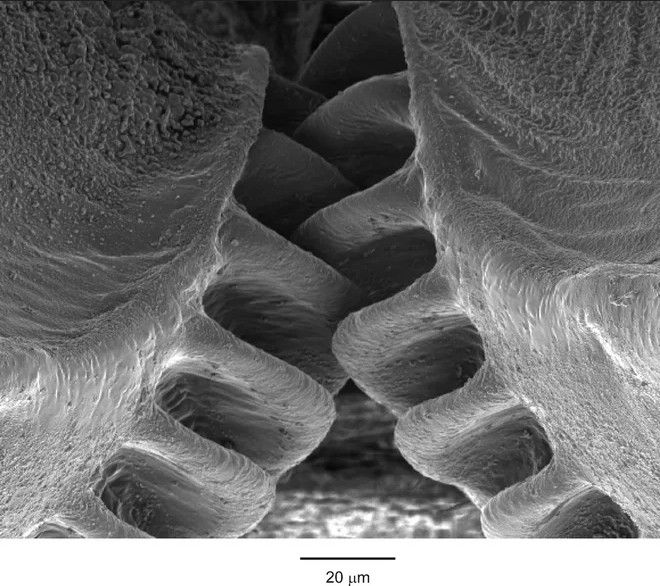
There is a belief in biology that goes like this: Biology is messy. Nature has no interest in making things easy to understand. So for many scientific questions, there will not be a straight-forward answer.
- Q: Where and how is a particular memory stored in the brain? A: Biology is messy; memories are distributed all over the brain and stored in many different forms: as molecules and as structure, inside neurons and in the connections between them.
- Q: How do genes determine the number of fingers per hand? A: Biology is messy; there isn’t a single factor for it. It emerges from the interactions of numerous different genes.
Now it is not always the case that our answers are so unsatisfying. Ask a biologist how the eye works and, well, there are quite a lot of similarities to how cameras work. And living organisms aren’t messy globs of formless flesh. They have an organized body plan, with separate organs, each responsible for specific functions that we can talk about; the heart pumps blood and the lungs pump air.
What we mean when we say “biology is messy” is that biology is as messy as it can be. Sometimes, biological systems need to abide by certain principles to accomplish things. The principles of optics drove the eye to include an adjustable lens, an adjustable aperture, and a two dimensional sensor upon which images are projected.
When we humans design something we try to make them as organized and intelligible as possible. When nature designs things they usually end up being messier than they need to be. In other words: biology is messy, unless it cannot afford to be. Natural selection does not care about elegance for the sake of elegance. Nature selects for traits and features that help organisms survive and reproduce. And if most of the solutions to a problem are messy, it will most probably pick a messy strategy. But if there is a cost associated with messiness that entails a selective disadvantage, then nature will tend to select a non-messy strategy.
Here is why I usually dislike it when people say “biology is messy”. When the messiness of biology is invoked, it is usually to rationalize why we don’t have an easy to understand explanation for some biological process (as is the case for the two example questions above). But we don’t know if this is because a simple explanation does not exist, or because we simply haven’t found it yet. Everything looks messy until you really understand how it works. This is even true for synthetic devices like radios or microprocessors.
A historical example of how appealing to the messiness of biology can be misleading, is the old idea that genes are proteins. This was a widespread belief among biologists until the discovery of DNA. People used to think that inheritable traits emerged from the protein composition of a cell. The collection of proteins led one cell to become a turtle and one cell to turn into a butterfly. That idea was a far messier – less elegant – solution than having genes be written into strings of nucleotide (more on this later).
There is one particular usage of the “biology is messy” statement, that can actually be productive in my view. If we believe that “biology is messy unless it cannot afford to be” then we ought to believe in its corollary. In situations where biology is not messy, it is because it cannot afford to be messy due to some fundamental principles or constraints. We often run into things in biology that look like things humans design. When this happens, it suggests that there are some principles of design that are inherent to the problem at hand. We can then search for those principles that led nature to select a conceptually clean and simple solution, similar to how the evolution of the vertebrate eye was guided by the principles of optics to function an awful lot like a camera.
Take the the discovery of mechanical gears in insects, for instance. Gears are quite common in machines designed by humans. It is a conceptually simple solution for transferring torque between unaligned axes. Gears were not known to exist in nature until the discovery of functional mechanical gears in tiny insects called planthoppers. The planthopper’s gears synchronize the two hindlegs during a jumps.

Why would nature come up with such a neat solution? Leg synchronization is possible without gears. So why does it only appear in the planthopper, but nowhere else in the animal kingdom? There must be something about its purpose that could not have been easily achieved without gears.
The answer probably lies in the fact that, due to their small size, planthoppers only have less than a millisecond to accelerate. Within a span of 0.8ms they need to accelerate at over 700g to reach speeds of nearly 5 meters per second (Burrow, 2007). This is an exceptional regime of acceleration and requires sub-millisecond coordination of leg movement. If one legs starts moving half a millisecond earlier, the other leg would barely have any time left to push against the surface.
According to Burrow & Suttons, 2013, if leg movements are slightly uncoordinated during a jump the planthopper would spin, uncontrollably, in the horizontal plane. This is because the hindlegs rotate on a nearly horizontal plane underneath the body in planthoppers (whereas hindlegs of fleas and crickets rotate on separate vertical plane alongside the body). The gears provide a method of mechanical synchronization, enabling the legs to move within roughly 30 μs of one another.
But this is not the full story and there are still many unsolved questions regarding why gears evolved. Planthoppers lose their gears after they molt into adults and yet are nearly just as good at jumping. Adult planthoppers use a friction-based method of leg synchronization. Why was that not an adequate solution for younger nymphs? Leafhoppers and froghoppers, which also rotate their hindlegs in a nearly horizontal plane, jump without using mechanical gears. Froghoppers achieve very precise movement synchronization between their hindlegs (32±22 μs, according to Burrow & Sutton 2010). (I learned from my personal correspondence with Prof Burrow that the synchronization mechanism in froghoppers is unknown but likely to be mechanical).
The point here is that the presence of gears is an indication of some principles of design that is common across natural and artificial systems. (Can you identify those principles? What can gears do that other strategies cannot fulfill?) While those design principles can be ignored in most animals, the behavioral requirements in planthopper are so stringent that they have forced those principles onto the biological scene. (I am not convinced that we have identified all those requirements, since froghoppers and adult planthoppers seem to be just fine without gears).
But if we’re dedicated to the biology is messy assumption, we should be motivated to further investigate planthopper behavior/physiology until we find something that make those gears seem indispensable. (We are already very close to finding it and the idea of it having to do with the size of the insect has already been explored). Now, it would be quite impressive if someone had gone the opposite route: predicted the existence of gears simply from studying planthopper behavior and the physics of jumping in small creatures. Would that have been possible?
This brings us to another domain of nature that is the main reason I am bringing up all of this. DNA and RNA are polymers of nucleotides or strings made up of an alphabet of four symbols. The cell appears to treat these nucleotides as abstract symbols that can be used to represent arbitrary things. The cell represents each of the 20 amino acid using a sequences of three nucleotides called codons. Some codons represent, not an amino acid, but an instruction to “stop” at the end of a sequence. What an elegant intelligible system! How reminiscent of the way computers use strings of binary symbols to encode data and instructions!
I would like to leave you with this question: Why do all living organisms use strings of abstract symbols? Or, under the biology is messy assumption, what functions are being fulfilled by DNA and RNA that would be difficult to fulfill through messier methods? What requirements forced digital coding through strings composed of a small alphabet onto the biological scene? Hopefully, you don’t think the answer is trivial. I will let you think about it and return to this question in a future post.

What you refer to as “abstract symbols” could be anything but. You can have a string of hammers and nails, but that doesn’t make them abstract by nature. We are the abstractors, and we do it to clarify and fit every phenomenon into one of our neat mental boxes, but that doesn’t mean our boxes are truly representative of the world. This is why proteins were thought to be the genes in the first place. They were the best box available at the time to put the gene concept in.
If we are to believe the RNA world hypothesis (some call it a theory!) or one of its nearest neighbors, then these abstract symbols were actually functioning hammers and nails, originally. Then, much later, abstract higher (or depending on what your model is, lower) levels of organization happened to evolve that allowed proofreading and sort of a double-entry bookkeeping, so that these slower, more expensive, yet more stable and hi-fi resulting organisms would reach our abstract observer’s sampling eye.
As far as what functions are being fulfilled by DNA and RNA, it could be that this is a locally optimal way to store and recover functional information
I’m not going to pretend I understand all of this, but apparently some people far smarter than me presume that 4 bases and 3-item codon matching may be an implementation of Grover’s algorithm